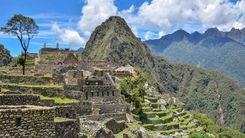If it weren’t for the abundant stalls and shops selling jungle craft goods it would be hard to know that this place was once dominated by hunter-gatherer tribes like the Iquito, Yaguar, Bora and Witito who initially defended their territory against the early Spanish missionaries and explorers. The townsfolk today, however, are warm and welcoming, wear as little clothing as possible and are out in numbers during the relative cool of the evening.
Brief history
Though founded in 1757 under the name of San Pablo de los Napeanos, the present centre of Iquitos was established in 1864. By the end of the nineteenth century Iquitos was, along with Manaus in Brazil, one of the great rubber towns. From that era of grandeur a number of structures survive, but during the last century the town veered between prosperity (as far back as 1938, when the area was explored for oil) and the depths of economic depression. However, its strategic position on the Amazon, which makes it accessible to large ocean-going ships from the distant Atlantic, has ensured its continued importance. At present, still buoyed by the export of timber, petroleum, tobacco and Brazil nuts, and dabbling heavily in the trade of wild animals, tropical fish and birds, as well as an insecticide called barbasco, long used by natives as a fish poison, Iquitos is in a period of quite wealthy expansion.
Puerto Belén
The most memorable part of town – best visited around 7am when it’s most active – Puerto Belén looms out of the main town at a point where the Amazon, until recently, joined the Río Itaya inlet. Consisting almost entirely of wooden huts raised on stilts and, until a few years ago, also floating on rafts, the district has earned fame among travellers as the “Venice of the Peruvian Jungle”. Actually more Far Eastern than European in appearance, with obvious poverty and little glamour, it has changed little over its hundred or so years, remaining a poor shanty settlement trading in basics like bananas, manioc, fish, turtle and crocodile meat. While filming Fitzcarraldo here, Werner Herzog merely had to make sure that no motorized canoes appeared on screen: virtually everything else, including the style of the barriada dwellings, looks exactly the way it did during the nineteenth century.
Iquitos fiestas
Iquitos throws some good annual festivals. The carnival known as Omagua (local dialect for “lowland swamp”) has grown vigorously over recent years and now involves not only townspeople, but hundreds of Indians as well, with plenty of chanting and dancing. The main thrust of activities is on the Friday, Saturday and Sunday before Ash Wednesday, and on Monday the town celebrates with the traditional Umisha dance around a sacred tree selected for the purpose. It’s similar to maypole dancing in Britain, though in Iquitos the dancers strike the tree with machetes; when it eventually falls, children dive in to grab their share of the many gifts suspended from it.
Perhaps the best time to visit Iquitos, however, is at the end of June (supposedly June 23–24, but actually spread over three or four days), when the main Fiesta de San Juan takes place. The focus is on the small artesanía market of San Juan (the patron saint of Iquitos), some 4km from the city and quite close to the airport. It’s the traditional time for partying and for eating juanes, delicious little balls of rice and chicken wrapped in jungle leaves; the best place for these is in San Juan itself. June is also the month for Iquitos Week: seven days of celebrations around the Fiesta de San Juan, though tending to spread right across the month.
In October the local tourist board organizes an international rafting competition, which draws enthusiasts from every continent for a five-hour, nineteen-kilometre river race, plus a longer six-day race. At the end of the month there’s the Espiritos de La Selva (Spirits of the Jungle) festival, which coincides with Hallowe’en and All Souls, and involves street processions with costumes depicting mythological figures, plus the usual communal drinking and eating.



